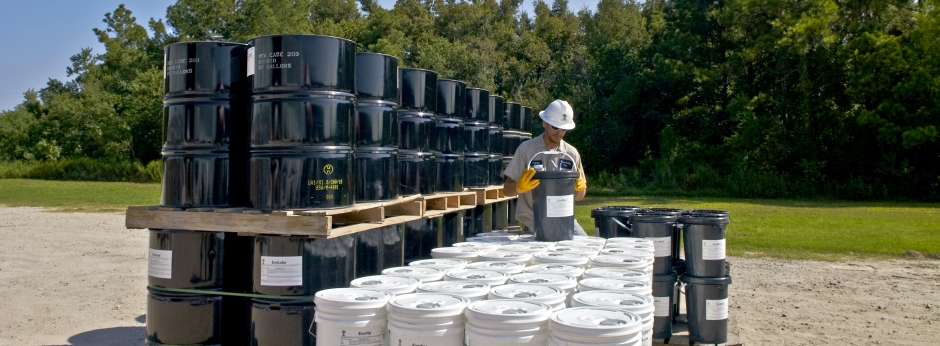Soluciones sistemáticas
Soluciones sistemáticas


El aumento de las técnicas de producción
1. Deep acidified solution of dash adjustment mud acid
The solution is used for formation with severe mud contamination and loose cement, the principle is: by using the natural ion-exchange function of clay, it is to generate HF on the clay surface so to dissolve clay and melt kaolinite, and to link them in flakes so to prevent moving of clay particles.
Based on the above principles, the laboratory tests were conducted: the measure of cation exchange capacity of the clay, dissolving property of acid solubility to the sand and clay, the effects of solutions with different concentrations on clay and the rate of penetration, the results indicate that the acid solution only works on clay sandstone, and has no impact on sandstone without clay, and is better than conventional mud acid in changing the permeability and effect depth.
Since the application, the acid solution has been used on hundreds of wells, increasing oil production of 1.2 million tons, with a success rate of over 80%; Field experiments show that the acid is suitable for processing sandstone formation of mud glue, clay contamination, and loose sandstone.
2. Deep acidified solution of organic potential acid
The organic potential acid is a free acid mixed by organics based material and ammonium salt under certain conditions, because it is generated in the formation, this acid can achieve the purpose of deep acidification and reduce the corrosion of equipment. Laboratory experiments show that the reaction rate of this acid with rock compositions, under the same conditions, is 6-8 times slower than those of mud acid and hydrochloric acid, and the final acid dissolution rate is similar with those of the two conventional acids, and almost no corrosion on the equipment and oil pipes. Also it is shown that this acid can prevent or reduce secondary pollution damage when used for processing formation.
This acid is suitable for formation with temperatures of 70-150 ℃, with effect distance of 25-30m.
Since the application, totally it has been used for more than 180 times, cumulatively increased oil production of about 120,000 tons of oil, and increased water injection of 900,000 cbm, such as pure 2-13 well, its validity is up to 3.2 years, the cumulative increase of oil is 13,700 tons.
3. Deep acidification technique of gelled acid
Gelled acid is a thickener of high-molecular polymer, and a retarder acid with 20 ~ 28% Hel corrosion inhibitor and other additives added as primary agent. Laboratory study results showed that the reaction rate of gelled acid with limestone is 3-7 times lower than that of the conventional hydrochloric acid with the same concentration, and there are some sticky (≥36mpa •s), after the open of formation, it can evenly promote in the formation, not only reduce fluid loss, and also evenly dissolve and corrode formations, playing a protective role for the reservoir near wellbore. At present, gelled acid has been used on 20 wells in oilfields of Victory, Xinjiang, Jidong, and has achieved good results, such as the Old Three well, its oil production amount rose to 103t / d from 8t / d.
4. Foam acid technology
Foam acid treatment technology is an increase production technology developed in the late 1970s in foreign countries. Foam acid is a acid solution composed by hydrochloric acid (or mud acid), a foaming agent, foam stabilizer and other additives, formed by nitrogen or carbon dioxide, so called foam acid; this acid can reduce the oil-water interfacial tension, prevent oleic acid emulsion, slow reaction with rocks, effective distance long, and low fluid loss. Less working fluid used and thorough backflow of residual acid reduce formation damage, and also because it has some viscosity, it can acidify and fracture low permeability reservoirs, by overcoming some of the defects of other acids, especially suitable for low permeability reservoir transformation.
The technology has been used in the field for 8 years, and achieved good effect of increasing oil.
5. Combined process of fracturing and acidizing technology
(1) Preposition fracturing liquid and acid techniques acid
That is, after pre-fracturing fluids, plenty of thickening acid will be used as the working fluid, in order to overcome its shortcomings of low shear resistance, for a large-scale acidification purposes. This technology is applied in the gas wells.
(2) Preposition acid hydraulic fracturing technology
That is, using some acid solution before fracturing, which not only reduces the formation fracture pressure, but also improves the efficiency of fracturing. The technology is used widely.
(3) Closing split fracturing acidifying fracturing technology
The technology is to use acid (thickening acid) under conditions of high pressure and large displacement, to open formation, then turn off the pump for 10 minutes, so the acid in the fracture surface will have adequate reactions, so to forming a convex surface, and to increase the fracture conductivity, and then inject acid deeply into the formation, so to increase the effective distance of acid and to achieve deep transformation purpose.



